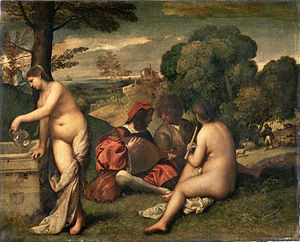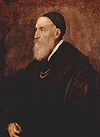- Pastoral Concert
-
Pastoral Concert 
Artist Titian or Giorgione Year c. 1510 Type Oil on canvas Dimensions 118 cm × 138 cm (46 in × 54 in) Location Louvre Museum, Paris The Pastoral Concert is an oil painting attributed to one of the Italian Renaissance masters Titian or Giorgione. It is located in the Louvre Museum in Paris, France.
History
The painting was originally attributed to Giorgione, but modern critics assign it more likely to his pupil Titian, due to the figures' robustness which was typical of his style.[1] It is also likely that Giorgione (whose works included elements such as music, the pastoral idleness and simultaneous representation of the visible and invisible) began the work, and then, after his death in 1510, it was finished by Titian.[1]
The work was owned by the Gonzaga family, perhaps inherited from Isabella d'Este: it was later sold to Charles I of England and then to French banker Eberhard Jabach; he in turn sold it to Louis XIV of France in 1671[2]
The painting was also attributed to Palma the Elder and Sebastiano del Piombo.[3]
In 1863, French painter Edouard Manet painted his Le déjeuner sur l'herbe after watching the Pastoral Concert in a visit to the Louvre museum.[4]
Description
The painting portrays three young people on a lawn, playing, while next to him a standing woman is pouring water from a marble basin. Both the women are naked, aside from two light vests; the two men, who are talking, are dressed with contemporary costumes. In the wide background is a shepherd and, among the vegetation, a far landscape.
The subject was perhaps the allegory of poetry and music: the two women would be an imaginary apparition representing the ideal beauty, stemming from the two men's fantasy and inspiration. The woman with the glass vase would be the muse of tragic poetry, while the other one would be that of the pastoral poetry. Of the two playing men, the one with the lute would represent the exalted lyric poetry, the other being an ordinary lyricist, according to the distinction made by Aristotle in his Poetics. Another interpretation suggests that the painting is an evocation of the four elements of the natural world (water, fire, earth and air) and their harmonic relationship.[4]
References
- ^ a b Fregolent, Alessandra (2001). Giorgione. Milan: Electa. p. 111. ISBN 88-8310-184-7.
- ^ "Le concert champêtre". Louvre Museum website. http://cartelen.louvre.fr/cartelen/visite?srv=car_not_frame&idNotice=22879&langue=fr. Retrieved 9 May 2011.
- ^ Milan, Francesco (1969). L'opera completa di Tiziano. Rizzoli. p. 93.
- ^ a b Zuffi, Stefano (2008). Tiziano. Milan: Mondadori Arte. p. 32. ISBN 978-88-370-6436-5.
Titian (List of works) - Christ Carrying the Cross (1508–09 – also attributed to Giorgione)
- St. Mark Enthroned (c. 1510)
- Pastoral Concert (c. 1510 – also attributed to Giorgione)
- Jacopo Pesaro being presented by Pope Alexander VI to Saint Peter (1506–11)
- A Man with a Quilted Sleeve (1510)
- Miracle of the Jealous Husband (1511)
- The Three Ages of Man (1512–13)
- Balbi Holy Conversation (c. 1512–1514)
- Woman at the Mirror (c. 1512–15)
- Sacred and Profane Love (1513–14)
- Tarquin and Lucretia (1515)
- Violante (c. 1515)
- Flora (c. 1515)
- Vanity (c. 1515)
- Salome (c. 1515)
- Young woman in a black dress (c. 1515)
- The Tribute Money (c. 1516)
- Assumption of the Virgin (1516–1518)
- The Worship of Venus (1518–20)
- Portrait of Vincenzo Mosti (c. 1520)
- Gozzi Altarpiece (1520)
- Venus Anadyomene (c. 1520)
- Malchiostro Annunciation (c. 1520)
- Bacchus and Ariadne (1520–23)
- Averoldi Polyptych (1520–22)
- Man with a Glove (c. 1520–23)
- The Bacchanal of the Andrians (1522–24)
- The Entombment (1525)
- Portrait of Federico II Gonzaga (c. 1529)
- The Madonna of the Rabbit (1530)
- Portrait of Charles V with a dog (1533)
- Penitent Magdalene (1533)
- Portrait of Giacomo Doria (1533–35)
- Portrait of Isabella d'Este (1534–36)
- Portrait of Ippolito de' Medici (1533)
- Venus of Urbino (1538)
- St. John the Baptist (1540)
- Portrait of Clarissa Strozzi (1542)
- The Crowning with Thorns (1542–43)
- Portrait of Pope Paul III (1543)
- Portrait of Pietro Aretino (1545)
- Portrait of Lavinia Vecellio (c. 1545)
- Self-Portrait (1546–47)
- Pope Paul III and his Grandsons (1545–46)
- The Tribute Money (1545–68)
- Equestrian Portrait of Charles V (1548)
- Portrait of Charles V (1548)
- Portrait of Isabella of Portugal (1548)
- The Martyrdom of Saint Lawrence (c. 1548–59)
- Philip II in Armour (1550)
- Venus and Adonis (c. 1553)
- Danaë (series) (1553–56)
- Mater Dolorosa (c. 1555)
- Portrait of Queen Christina of Denmark (1555-1556)
- Diana and Actaeon (1556–59)
- Diana and Callisto (1556–59)
- Crucifixion (1558)
- The Entombment (1559)
- St Margaret and the Dragon (c. 1559)
- Annunciation (church of San Salvador) (1559–64)
- The Death of Actaeon (c. 1559–75)
- Madonna and Child with Saints Luke and Catherine of Alexandria (c. 1560)
- Self-Portrait (c. 1560)
- Venus and Adonis (c. 1560)
- Penitent Magdalene (1565)
- Venus Blindfolding Cupid (c. 1565)
- Allegory of Prudence (c. 1565–70)
- Tarquin and Lucretia (1569–71)
- Punishment of Marsyas (1570–1576)
- Saint Sebastian (c. 1575)
- Saint Jerome in Penitence (1575)
- Pietà (1576)
 Categories:
Categories:- 1500s paintings
- Titian paintings
- Giorgione paintings
- Paintings of the Louvre
Wikimedia Foundation. 2010.
